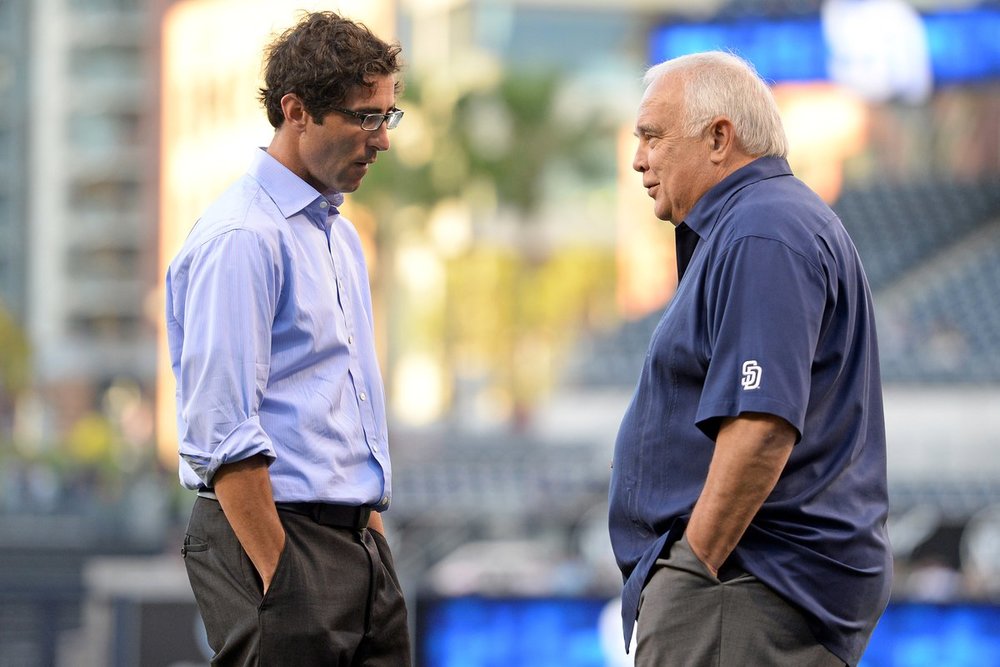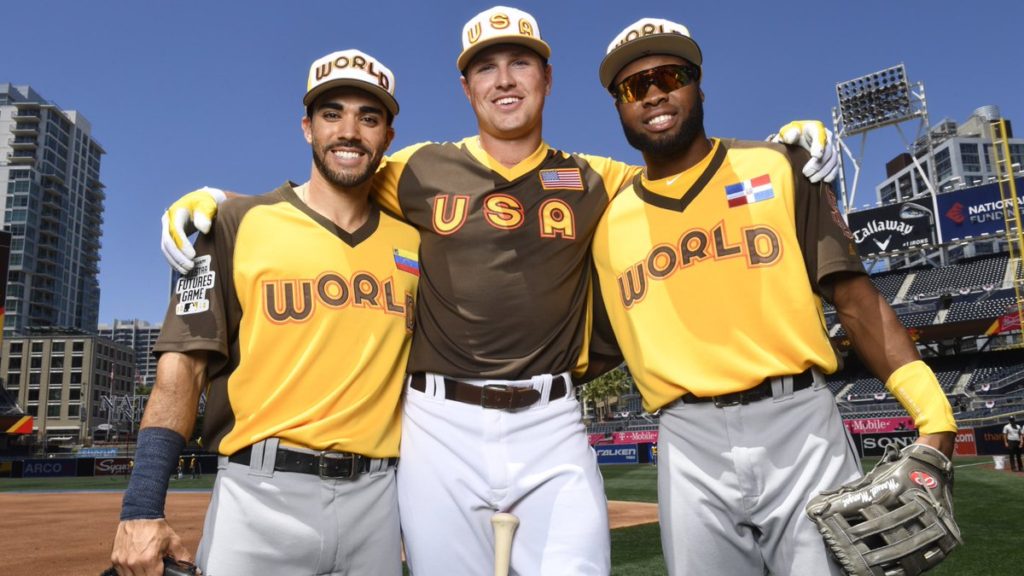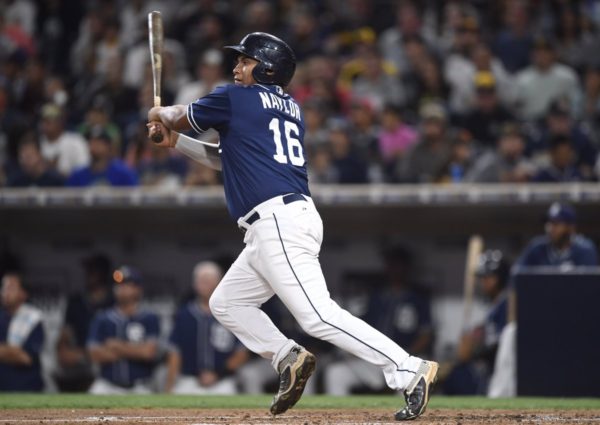Six Signs the Padres’ Plan is Working Or Not


The Progress of Key Prospects—especially A.J. Preller draftees or acquisitions
This will help us gauge the worth of the Padres’ investment in scouting and player development. It will also help us see what kind of talent scout A.J. Preller really is. The odds of even top prospects becoming impact major leaguers are relatively lean, and future impact players don’t usually languish long in the minors. Watch Anderson Espinoza, Adrian Morejon, Cal Quantrill, Eric Lauer, Buddy Reed, Hudson Potts, etc. Also pay attention to the speed with which they progress through the system. More on that later.
Moves to develop organizational balance
The Padres have an organizational balance problem that can be seen throughout the minor leagues and the MLB level as well. Their surplus of second-basemen and outfielders is approaching absurdity, as is the absence of a shortstop or quality starting pitching at the high-end of the system. Andy Green himself has noted it. The good news is A.J. Preller can make trades to create more balance in the system whenever he wants. He needs to. When you see this happen, you’ll know the plan is on track. The Padres will begin to seek certain positions because they know they need them soon. Many of the prospects they drafted as shortstops are already playing other positions (Potts), are suspected to (Tatis Jr.), or seem to have stalled out in the minors (Guerra, Rondon). In a division where the Padres are competing against teams with the likes of Corey Seager, Brandon Crawford, and Trevor Story at shortstop, the Padres must upgrade. Teams are built from the middle out. Other prospects, like Josh Naylor, are buried behind the Padres’ anchor players. This is an easily fixable dilemma. One must hope A.J. Preller sees this, and plans to act at the appropriate time.
Some move to obtain quality MLB-caliber pitching
Let’s not kid ourselves. The Padres rotation will be God-awful over a whole season. Even with the over-achievement of the starting staff for the first 25% of the season, the Padres team ERA ranks 26th out of 30 MLB teams. The highly-regarded bullpen has been awful lately. If one looks only to future prospects for the answer, one is probably heading for disappointment. The Padres don’t have five quality MLB starting pitchers in their system. They don’t. No one does. If they do, they certainly won’t arrive at the same time, stay healthy, and mature to the same level of excellence while in the majors. The Padres have some extremely promising young talent. Unfortunately, most of it is young and unproven talent in a game known for humbling talent as it moves toward MLB—whether through difficulty, injury, or character implosion. Matt Bushs, Donovon Tates, Casey Kellys and Cory Luebkes abound. That’s baseball. The good news is the Padres have hope and potential to burn. One would think some of these kids will pan out. A.J. Preller knows he will have to acquire some quality, proven MLB pitching. When you see him make that move, you’ll know he thinks the Padres are ready to contend.
Who the Padres draft third overall in this year’s draft

The age, position, and constitution of that selection may tell us a fair amount about where the organization thinks it is going in the foreseeable future. For the record, I’d love to see high-schooler Hunter Greene (Sherman Oaks, CA) in a Padres’ uniform—even though he’s young. If he doesn’t fall to the Padres, Kyle Wright or Brendan McKay will hit the spot as well. Both are mature pitchers who have played against top college competition successfully and could help the big-league squad sooner rather than later.
An obvious sense of urgency
Will the Padres move prospects through the organization as quickly as prudently? Or, will they keep them down unnecessarily to save money or maximize control? Remember, the Padres can have relative control for a player’s career—if they are willing to pay for that control. It is only to ownership’s advantage to keep a player in the minors “until the team gets good,” or to maximize years of control. They can always sign them to an extension. Teams shouldn’t wait until the team is “good” to bring up prospects. No more circular reasoning. Bring them up when they are ready—that’s how the team actually gets good. Historically, the Padres home-grown, top prospects tend to come to the majors for good later than most franchises. Many franchise’s top prospects arrive from ages 21-23. The Padres top prospects tend to arrive in the majors for good at 24-26 (Renfroe, Hedges, Spangenberg, Dickerson, Jankowski). Outliers typically come from other franchises or are Rule-5 picks, where they are thrust into the majors. Why? It could be 1) the Padres don’t draft well and thus their prospects aren’t as good, 2) their development is subpar, or (3) they drag their feet to preserve money and control at the expense of the MLB product and the career length of the prospects. Given the Padres’ recent affection for the Rule-5 draft (where players are simply thrust into the majors from Rookie or A-ball)—it would seem to be the latter two. Another factor could be the organizational imbalance mentioned above. There is simply no place for prospects to advance to because the seat is already occupied.
Good news. This is an easy fix.
Increased spending on payroll
For all the hyperbole surrounding the Padres spending on the international market (they won’t be able to spend a fraction of that in the near future—it’s like pre-paying your international spending—and much of that was spent on penalties—not players), draft (the pools are what they are for the most part…and every team must spend money to sign draftees unless you decide to secede from the draft), they must do much better. Let me say this gently: the active Padres payroll is a disgrace to the city. Ron Fowler and company can and must do better to put a decent MLB product on the field—particularly—the mound. Nothing about cutting payroll itself allows you to acquire more prospects or make your team better. Slashing payroll only saves ownership money. Padres ownership slashed payroll while not adjusting ticket prices, benefits to season ticket holders, etc. So, fans, not ownership—are paying for the rebuild necessary because ownership misfired the first time. The poor on-field product is being met with lackluster attendance, which means less revenue, which means less spending, which means a poor on-field product, which means lackluster attendance…you get the picture. The re-signing of Wil Myers was a welcome step forward. However, it is not enough. It’s a start.
Reality check: the Cubs never let their payroll drop below $89 million at any point of their rebuild and won the championship with a $167 million dollar payroll. After a nearly five-season journey, the refurbished Astros made the playoffs once and missed them last year with a $96 million dollar payroll. They are looking fantastic this season with a $123 million dollar payroll. The $32 million active Padres payroll is a laugher. With lots of dead salary coming off the books soon and no ability to spend a fraction of similar money on international signings going forward—the spotlight is on ownership.
Show us we can believe in the plan…and we will.
How will the Padres fans know they are heading toward becoming the next Cubs or Astros, and not the next Twins or Reds? Look at the six measures above.
Tim is a former pitcher and avid, life-long baseball fan. He is also a husband, father, pastor, writer, and professor…who drinks a lot of coffee.